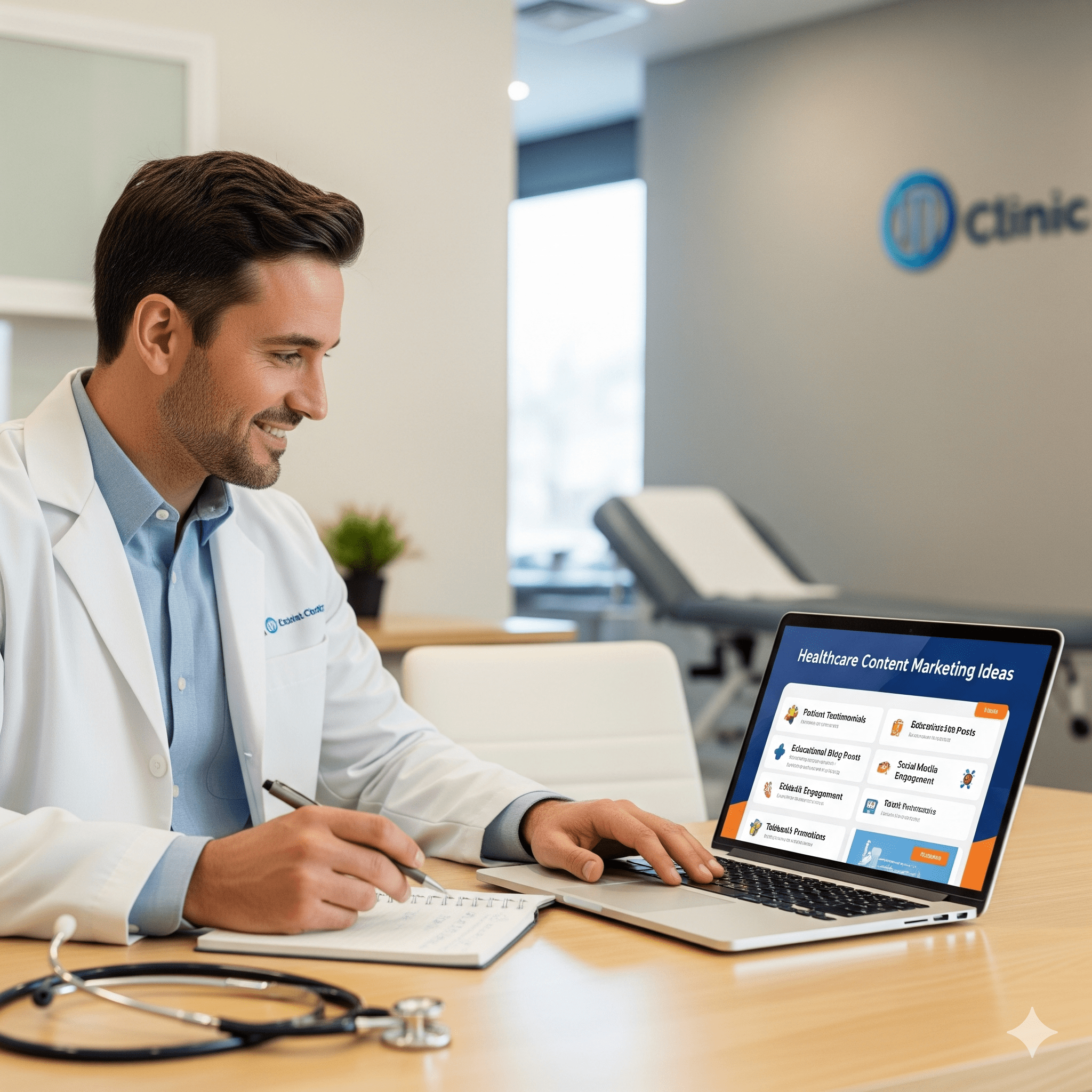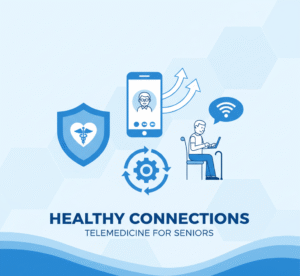“Find 20 powerful healthcare content marketing ideas to attract new patients, from debunking myths in blog posts to sharing patient testimonials, all designed to build trust and grow your practice.”
In today’s digital world, the waiting room is no longer the first place a potential patient meets you. Their journey begins much earlier, often with a late-night Google search for symptoms, a question posted on a community forum, or a scroll through social media. If your medical practice isn’t present in these digital spaces, you miss a massive opportunity to connect with, educate, and ultimately attract new patients.
This is where content marketing comes in. It’s not about flashy ads or pushy sales tactics. Instead, it’s about providing genuine value. It’s about answering the questions your potential patients are already asking, easing their anxieties, and building a foundation of trust before they even book an appointment. Solid healthcare content marketing ideas are the cornerstone of any modern medical practice marketing plan.
But let’s be honest. Coming up with fresh, engaging content can feel daunting, especially when you’re busy running a practice. Where do you even start? What do patients actually want to see?
We’ve got you covered. Below are 20 practical and powerful healthcare content marketing ideas to build your online presence, engage your community, and keep a steady stream of new patients coming through your doors. These patient acquisition strategies work because they prioritize the patient’s needs.
1. Myth vs. Fact Blog Posts
Misinformation about health is rampant online. This creates a perfect opportunity for you to step in as the trusted authority. Create content that directly addresses and debunks common myths within your specialty.
- Why It Works: This format immediately establishes your expertise and shows you are in touch with your community’s concerns. It helps correct dangerous misconceptions and builds immense trust. Patients are actively searching for clear, correct answers, and you can be the one to provide them.
- How to Do It: Choose a common condition or treatment in your field (e.g., acne, knee pain, seasonal allergies, dental implants). Create a list of 5-7 common myths you hear from patients. Then, address each myth one by one, labeling it “Myth,” and follow it with a clear “Fact” section where you explain the reality using simple, easy-to-understand language.
- Example: A cardiologist could write, “Heart Disease Myths Debunked: Fact vs. Fiction.” An orthodontist might create a post titled, “5 Myths About Adult Braces You Need to Stop Believing.”
- Keywords to Target: “[Condition] myths,” “facts about [treatment],” “is [health claim] true.”
2. A “Day in the Life” Video or Photo Series
Patients often feel anxious about medical visits because the environment is unfamiliar. Humanize your practice by showing them the people and processes behind the scenes. This is a fantastic tool for improving patient engagement strategies.
- Why It Works: This content removes a medical office’s clinical, sterile feel and replaces it with warmth and personality. It shows your staff’s friendly faces, the facility’s cleanliness, and the care you put into your work. This transparency can significantly reduce a new patient’s anxiety.
- How to Do It: Use your smartphone to capture short video clips or photos throughout a typical day. Introduce your front desk staff, show a technician sterilizing equipment, or feature a doctor enjoying a morning coffee before appointments begin. You can post these as an Instagram or Facebook Story, a short TikTok or Reel, or a compiled video on your YouTube channel.
- Example: A pediatric dental office could show the team setting up the “treasure chest” for kids, a hygienist explaining a tool in a non-scary way, and the cheerful waiting room.
- Keywords to Target: “Meet the team at [Your Practice Name],” “[Your City] [Your Specialty] office tour,” “friendly doctor in [Your City].”
3. Detailed Procedure and Service Guides
When patients are considering a specific procedure, they have dozens of questions. They want to know what it is, if it’s right for them, how to prepare, what the recovery is like, and how much it might cost. A comprehensive guide on your website answers all these questions in one place.
- Why It Works: This is a powerhouse for healthcare SEO techniques. People use search engines to find detailed information. A thorough guide that answers their questions positions you as the expert and keeps them on your website longer. It pre-qualifies patients, as they arrive at their consultation already well-informed and confident in your ability to help.
- How to Do It: Dedicate a whole page on your website to each core service. Use clear headings for each section: What Is [Procedure Name]?, Who Is a Good Candidate?, The Consultation Process, What to Expect on the Day of the Procedure, Recovery and Aftercare, and Frequently Asked Questions. Use diagrams, photos, or short videos to explain complex concepts.
- Example: A dermatology clinic could create “The Ultimate Guide to Chemical Peels” or “Everything You Need to Know About Mohs Surgery.”
- Keywords to Target: “What is [procedure name],” “[procedure name] recovery,” “how to prepare for [procedure name],” “cost of [procedure name] in [Your City].”
4. Authentic Patient Testimonial Videos
You can talk about how great your practice is all day, but nothing is more powerful than a happy patient sharing their success story. Social proof is one of the most effective medical marketing tips.
- Why It Works: Testimonials provide a relatable, human story with which potential patients can connect. Hearing about a positive experience directly from someone with the same problem or fear is incredibly persuasive and builds instant credibility.
- How to Do It: First and foremost, ensure you have explicit, signed consent from the patient that complies with all HIPAA regulations. Ask happy patients if they would share their experience on camera. Use a simple setup with good lighting and clear audio. Ask them questions like, “What problem were you facing before you came to see us?” and “How has your life changed after the treatment?” Keep the final video short, authentic, and focused on their journey.
- Example: An orthopedic practice could feature a patient who can now play with their grandchildren again after a successful knee replacement. A weight loss clinic could showcase a patient’s emotional story of reaching their health goals.
- Keywords to Target: “[Your Practice Name] reviews,” “[Your Doctor’s Name] patient stories,” “best [specialty] in [Your City].”
5. Live “Ask Me Anything” (AMA) Sessions
Give your community direct access to your expertise through live video sessions. This is a dynamic way to engage with potential patients in real-time.
- Why It Works: Live Q&A sessions are interactive and transparent. They show you are confident in your knowledge and willing to engage directly with people’s concerns. It’s a great way to build a community around your practice and become the go-to resource in your area.
- How to Do It: Schedule a live session on Facebook, Instagram, or YouTube. Promote it for a week in advance, encouraging followers to submit their questions beforehand. Choose a specific topic for each session, such as “Managing Seasonal Allergies” or “Answering Your Questions About Dental Veneers.” During the live stream, answer the pre-submitted questions and any that come in through the comments. Remember to include a disclaimer that your advice is for informational purposes and does not replace an in-person consultation.
- Example: A family physician could host a back-to-school AMA on “Keeping Kids Healthy This School Year.” A sports medicine doctor could do a session on “Preventing Common Running Injuries.”
- Keywords to Target: This content is more for social engagement, but you can title the replay video with keywords like “Q&A about [topic]” or “expert advice on [condition].”
6. Symptom Checker Checklists and Infographics
People often turn to the internet to understand their symptoms. While you should never offer a diagnosis online, you can provide helpful, responsible resources that guide them on when to seek professional care.
- Why It Works: Visual content like infographics and checklists is highly shareable and easy to digest. It provides genuine utility to a worried individual, helping them organize their thoughts and understand the severity of their symptoms. This service builds goodwill and makes your practice the logical next step.
- How to Do It: Create a simple checklist or flowchart infographic titled, “Should You See a Doctor for Your Headache?” List common symptoms and corresponding advice, such as “If your headache is accompanied by [symptom X], seek immediate medical attention” or “If your headache persists for more than [Y hours], it’s time to book an appointment.” Always include a strong disclaimer.
- Example: An urgent care clinic could create an infographic on “Is It a Cold, the Flu, or COVID-19?” A gastroenterologist could design a checklist for patients to track their IBS symptoms before an appointment.
- Keywords to Target: “When to see a doctor for [symptom],” “[condition] symptoms checklist,” “what do my symptoms mean.”
7. “Behind the Scenes” Team Introductions
Your team is your greatest asset. Showcasing the people who make your practice work helps build a personal connection with potential patients.
- Why It Works: Patients want to be treated by people they can trust and like. Introducing your nurses, hygienists, physician assistants, and front desk staff by name and face makes your practice feel more like a family and less like a cold institution.
- How to Do It: Dedicate a section of your website to your team. Go beyond a name and a title. Include a professional photo and a short, fun bio for each person. Ask them to share a bit about their interests, why they chose a healthcare career, or their favorite part about working at the practice. You can also feature a “Staff Member of the Month” on social media.
- Example: A dental practice could feature a hygienist with a bio that says, “When she’s not helping patients achieve a sparkling smile, Sarah enjoys hiking with her golden retriever, Max.”
- Keywords to Target: “[Your Practice Name] team,” “meet the staff at [Your Practice Name].”
8. Timely Seasonal Health Tips
Health concerns change with the seasons. Align your content calendar with these changes to provide relevant, timely advice that people are actively looking for.
- Why It Works: This strategy taps into existing search trends and immediate needs. It shows that your practice is current and in tune with the health challenges your community is facing. It’s one of the most reliable healthcare social media ideas.
- How to Do It: Brainstorm topics for each season. Spring: allergy management, tips for starting an exercise routine. Summer: sun protection, hydration, and treating insect bites. Fall: flu shot reminders, managing back-to-school stress. Winter: avoiding colds and flu, managing dry skin, and recognizing symptoms of seasonal affective disorder. Create blog posts, short videos, or social media graphics for each topic.
- Example: An allergist could post a “Pollen Count Survival Guide” in April. A dermatologist could share a video on “How to Choose the Right Sunscreen” in June.
- Keywords to Target: “Summer health tips,” “how to avoid the flu,” “managing seasonal allergies.”
9. Anonymized Patient Case Studies
A case study tells a story. It details a problem, your solution, and the positive outcome. It’s a powerful way to demonstrate your expertise tangibly.
- Why It Works: Case studies are more compelling than simple claims. They walk a potential patient through your process, showing them how you diagnose issues, develop treatment plans, and achieve results for patients like them.
- How to Do It: Crucially, all patient information must be anonymized to comply with HIPAA. Change names, dates, and any identifying details. Structure the story clearly: 1. The Patient’s Challenge (e.g., “A 45-year-old active male presented with persistent shoulder pain.”). 2. Our Diagnostic Process and Findings. 3. The Treatment Plan. 4. The Outcome (e.g., “After six weeks of physical therapy and a targeted injection, the patient reported a 90% reduction in pain and has returned to playing golf.”).
- Example: A physical therapy clinic could write a case study about helping a patient recover from an ACL tear. A mental health provider could share a story (with extreme care for anonymity) about helping a patient manage anxiety.
- Keywords to Target: “[Condition] success story,” “[treatment] results,” “how to fix [problem].”
10. Technology and Equipment Explainers
Do you use state-of-the-art technology in your practice? Don’t assume patients know what it is or why it’s better. Explain it to them.
- Why It Works: Showcasing your advanced technology demonstrates your investment in providing the best possible care. It can be a key differentiator from your competitors. Explaining how it benefits the patient (e.g., less pain, faster recovery, more accurate diagnosis) makes the investment tangible to them.
- How to Do It: Create a short video or a webpage with photos explaining a specific piece of equipment. Don’t just list the technical specs. Focus on the patient benefits. For a 3D dental scanner, you could say, “This means no more messy, uncomfortable impression trays!”
- Example: A dental office with a CEREC machine can create a video titled “Get a Permanent Crown in a Single Visit!” An ophthalmologist can explain the benefits of their laser cataract surgery equipment.
- Keywords to Target: “Benefits of [technology name],” “[procedure] with [technology name],” “advanced [specialty] technology.”
11. Local Health News and Community Involvement
Position your practice as an integral part of your local community. Share and comment on local health news and showcase your team’s involvement in local events.
- Why It Works: This builds local relevance and shows that you care about the community’s well-being beyond your clinic walls. It’s a key part of any local healthcare SEO strategy, as it ties your practice to your specific geographic area.
- How to Do It: Share articles from your local news outlet about health trends in your town. Post photos of your team participating in a local charity 5K, sponsoring a Little League team, or giving a health talk at a local senior center.
- Example: Post on Facebook, “We’re so proud to sponsor the Northwood High School football team this season! Go Panthers! #CommunityHealth.” Or, “Great article in the [Local Newspaper] today about the importance of tick prevention in our area parks.”
- Keywords to Target: “[Your City] health news,” “[Your Practice Name] community involvement.”
12. “What to Expect at Your First Visit” Guide
The number one fear for a new patient is the unknown. A detailed guide that walks them through every step of their first visit can dramatically reduce anxiety and increase appointment show-up rates.
- Why It Works: This simple act of preparation shows empathy and care. It answers practical questions (Where do I park? What paperwork do I need?) and sets expectations for the clinical part of the visit. A prepared patient is a more relaxed and trusting patient.
- How to Do It: Create a dedicated page or a short video on your website. Show pictures of your office entrance, the front desk, and a treatment room. Explain the check-in process. List the documents they should bring. Briefly introduce who they will meet and what will happen during the exam or consultation.
- Example: “Your First Visit to [Our Practice Name]: A Step-by-Step Guide.” Include a link to download new patient forms in advance.
- Keywords to Target: “First visit to [specialty],” “what to expect at my first dental appointment,” “[Your Practice Name] new patients.”
13. Interactive Quizzes
People love quizzes. They are fun and engaging and can be an effective (and responsible) way to encourage people to learn more about a health topic.
- Why It Works: Quizzes turn passive content consumption into an active experience. They can help a user self-identify a potential need for your services in a low-pressure way.
- How to Do It: Use a simple quiz-building tool to create a short, 5-7 question quiz. The key is to be responsible. The result should never be a diagnosis. Instead, it should provide information and a gentle call to action. For example, a quiz titled “What’s Your Skincare Style?” could have a result that says, “Your answers suggest you have combination skin. Here are some tips for managing it, and if you’d like a personalized plan, we’re here to help.”
- Example: A hearing clinic could create a “How Well Are You Hearing?” self-assessment quiz. A nutritionist could offer a “What’s Your Nutrition IQ?” quiz.
- Keywords to Target: “[Topic] quiz,” “skincare quiz,” “hearing self-assessment.”
14. A Glossary of Common Medical Terms
The language of medicine can be intimidating. Create a simple glossary on your website that explains standard terms related to your specialty in plain English.
- Why It Works: This is a fantastic resource for patient education and an excellent SEO asset. Patients often search for definitions of terms they hear from their doctor or read online. By providing a clear, easy-to-understand glossary, you become a trusted resource and can attract significant search traffic.
- How to Do It: Create a single page on your website and list terms alphabetically. For each term, provide a concise, jargon-free definition.
- Example: An endocrinologist’s glossary might include terms like “A1C,” “Hyperthyroidism,” and “Insulin Resistance.” An orthopedic surgeon’s list might consist of “Arthroscopy,” “Meniscus,” and “Rotator Cuff.”
- Keywords to Target: “What does [medical term] mean,” “[specialty] terminology,” “define [medical term].”
15. Preventive Care Guides
Content shouldn’t just be for people who are already sick. Attract proactive, health-conscious patients by providing valuable guides on preventative care.
- Why It Works: This shifts the focus from treatment to wellness, positioning your practice as a partner in your patients’ long-term health. This type of content attracts a highly desirable patient demographic and is perfect for sharing in monthly newsletters.
- How to Do It: Create guides based on age, gender, or lifestyle. For example, “A Man’s Health Checklist for His 40s,” or “5 Preventive Screenings Every Woman Needs.” Break down the recommended tests, why they are essential, and when to get them.
- Example: A general practice could publish a “Complete Guide to Your Annual Physical.” A dentist could create a guide on “How to Prevent Gum Disease.”
- Keywords to Target: “Preventative care checklist,” “health screenings for women over 50,” “how to prevent [condition].”
16. Comparison Guides: Treatment A vs. Treatment B
When patients have a condition, they often discover multiple treatment options. This can be confusing. A guide that compares two or more options head-to-head is incredibly valuable.
- Why It Works: This type of content directly addresses a high-intent search query. A person searching for “dental implants vs. bridges” is actively in decision-making. By providing a balanced, informative comparison, you guide them through that process and position yourself as the expert who can help them choose.
- How to Do It: Use a table format for easy comparison. Create rows for criteria like “Procedure Time,” “Recovery,” “Longevity,” and “Cost.” Provide a balanced overview of the pros and cons of each option. Conclude by advising them that the best choice depends on their situation and requires a professional consultation.
- Example: An orthodontist: “Invisalign vs. Traditional Braces: Which is Right for You?” A cosmetic surgeon: “Botox vs. Dermal Fillers: Understanding the Differences.”
- Keywords to Target: “[Treatment A] vs [Treatment B],” “difference between [procedure 1] and [procedure 2].”
17. Simple “How-To” Videos
Create short, practical videos that teach your audience something valuable. These don’t need to be complex; they must be helpful.
- Why It Works: Video is the preferred content format for many people, especially on social media. “How-to” videos are practical and shareable. They demonstrate your expertise straightforwardly and helpfully.
- How to Do It: Keep the videos short (under 90 seconds). Use your phone and a simple script. Focus on a single, simple task.
- Example: A dentist could show “How to Floss Correctly.” A physical therapist could demonstrate “3 Simple Stretches to Relieve Lower Back Pain.” A pediatrician could show “How to Properly Swaddle a Baby.”
- Keywords to Target: “How to [task],” “best way to [task],” “stretches for [pain].”
18. E-books or Downloadable Guides
For more complex topics, offer a comprehensive guide that visitors can download in exchange for their email address. This is a classic digital marketing tactic for clinics to generate leads.
- Why It Works: This lets you capture contact information from interested patients. You can then nurture this relationship through an email newsletter, sharing more valuable content, and encouraging them to book an appointment.
- How to Do It: Choose a broad topic that warrants a deep dive, such as “The Expectant Parent’s Guide to a Healthy Pregnancy” or “A Runner’s Guide to Preventing Injury.” Design it using a simple tool like Canva and offer it as a PDF download with a simple form on your website.
- Example: A fertility clinic could offer a downloadable guide to “Understanding Your Fertility Journey.” A sports medicine practice could create an e-book on “The Athlete’s Nutrition Playbook.”
- Keywords to Target: “[Topic] guide download,” “free [topic] e-book.”
19. Guest Posts on Local Blogs
Expand your reach by sharing your expertise on other relevant local websites or blogs.
- Why It Works: This strategy puts your practice before an established, new audience. It also generates valuable backlinks to your website, which is a significant factor in improving your healthcare SEO.
- How to Do It: Identify local blogs your target patients might read (e.g., a “local mom” blog, a city lifestyle blog, a fitness studio’s blog). Reach out to them with a specific article idea that would provide value to their readers.
- Example: A pediatrician could write a guest post for a local parenting blog on “Navigating Toddler Sleep Regressions.” A dietitian could write for a local gym’s blog about “Pre- and Post-Workout Nutrition.”
- Keywords to Target: This is less about keyword targeting and more about brand exposure and link building.
20. Answering “People Also Ask” Questions from Google
Google is literally telling you what questions people are asking. Use this insight to create ultra-relevant content.
- Why It Works: The “People Also Ask” (PAA) section in Google search results is a goldmine for content ideas. Creating content that directly answers these questions increases your chances of ranking for those specific queries and even being featured in the PAA box yourself.
- How to Do It: Go to Google and type in a keyword related to your specialty (e.g., “root canal”). Scroll down to the PAA box and look at the questions. Create a blog post with a heading (H2 or H3), then provide a clear, concise answer underneath each question.
- Example: For “root canal,” the PAA questions might be “Is a root canal very painful?” and “How long does a root canal take?” You can create a blog post, “Answering Your Top Questions About Root Canals,” and address each directly.
- Keywords to Target: The PAA questions are your keywords! Use them as your headings.
Your Next Step: Putting These Ideas into Action
The list above provides a powerful starting point for any practice looking to enhance its medical practice marketing. The key, however, is consistency. Consistently creating valuable, educational, and engaging content builds momentum, grows your audience, and ultimately, attracts new patients.
But we understand. You are a healthcare professional, not a full-time content creator. Juggling patient care, staff management, and the daily business demands leaves little time for blog writing, video editing, and social media management.
This is where a strategic partner can make all the difference.
If you’re ready to grow your practice and reach more patients but need an expert team to handle your digital marketing, consider InvigoMedia. We are a leading digital marketing agency specializing exclusively in the healthcare industry. We understand the unique challenges and opportunities of marketing a medical practice, from navigating HIPAA compliance to connecting authentically with patients.
Our team of experts can help you implement these healthcare content marketing ideas and more. We offer a full suite of services designed to help you grow, including:
- Healthcare SEO: Helping patients find you first when they search on Google.
- Paid Advertising (PPC): Driving targeted traffic and new patient leads immediately.
- Custom Website Design: Creating a professional, user-friendly, and high-converting website for your practice.
- Patient Engagement Strategies: Building a loyal community around your brand through strategic content and social media.
Stop letting potential patients pass you by online. Partner with the experts at InvigoMedia and build a powerful digital presence that helps you reach more patients and confidently grow your practice.
Frequently Asked Questions (FAQs)
1. How often should my practice be posting new content?
Aiming for one new blog post per week is a great goal for most practices. For social media, two to four weekly posts on your primary platform (like Facebook or Instagram) can keep your audience engaged. The most important thing is consistency. It’s better to post one high-quality piece of content per week, every week, than to post five times one week and then go silent for a month.
2. Do I need to worry about HIPAA when creating content?
Absolutely. HIPAA is paramount. Never share any patient’s Protected Health Information (PHI) without explicit, written consent. This includes names, photos, videos, and any details that could identify them. When creating case studies, all details must be completely anonymized. Always err on the side of caution and consult a legal expert if unsure.
3. Which content type is best for my specific medical practice?
The “best” content depends on your specialty and your target audience. Instagram and video content (like before-and-afters) are highly effective for visual specialties like cosmetic dermatology or orthodontics. For specialties that deal with complex conditions, like oncology or cardiology, detailed blog posts, procedure guides, and Q&A sessions are excellent for building trust and educating patients. The best strategy is often a mix of different content types.
4. How do I measure the success of my healthcare content marketing?
Success can be measured in several ways. Key metrics to track include:
- Website Traffic: Are more people visiting your website from search engines and social media?
- Keyword Rankings: Are you appearing higher in Google search results for your target keywords?
- Engagement Rate: Do people like, comment, and share your social media posts?
- Conversions: This is the most important one. How many people fill out your “Book an Appointment” form or call your office directly from your content? Using tools like Google Analytics can help you track these metrics effectively.
5. Can I do all this myself, or should I hire a digital marketing agency?
It is possible to do it yourself, but it requires significant time, effort, and expertise. You must understand SEO, content strategy, video production, social media management, and data analysis. For most busy practice owners, this isn’t feasible. Hiring a specialized healthcare digital marketing agency like InvigoMedia allows you to leverage a team of experts who live and breathe this work, freeing you up to do what you do best: care for your patients.













